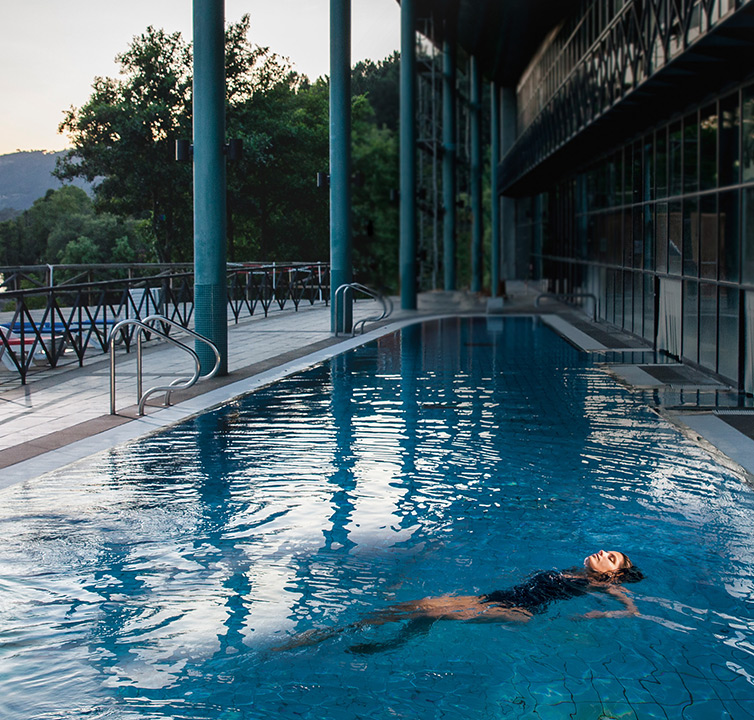The mild, rainy climate of the region lays a green carpet all over Galicia, a landscape mixture of meadows, gentle hills, woods and rivers that boasts one of the highest concentrations of mineral hot springs in Europe. Its 21 thermal spas, with acommodation up to 3.000 beds, represent more than the 20% of Spanish spa industry, welcoming around 150.000 visitors every year. No doubt that, after the Way of Saint James – the first European Cultural Route certified by the Council of Europe, also acknowledged by the UNESCO – thermalism is the tourism product with more international potential in Galicia.
Water in Galicia is plentiful,and besides the spas and thermal centres, the region is home to 10 mineral water bottling plants. Thalassotherapy centres are also very popular along Galicia’s coastline: almost 1700 km filled with sandy beaches and sailing ports.

Galicia's spas, equipped with modern facilities and a skilled medical staff, offer a wide range of l treatments that rely on the variety and quality of the many mineral springs, filled with therapheutic properties.
These water cures are usually combined with wellness treatments; beauty, well-being and relaxation programmes that provide a full rejuvenating and relaxing experience.
Galicia's thermal industry also represents a sustainable business model that works to ensure the future of this delicated resource, improve the quality of life of its guest and contributes to retain population in rural areas through job creation.
In addition, spas and thermal centres provide a social and economic stimulus for the districts where they are located.

Historical Background
Galicia has a long thermal tradition that goes back even before Roman times. From the Roman period itself, many archaelogical sites have been preserved and can be visited today, in Lugo, Ourense, Caldas de Reis or Caldelas de Tui, just to name a few
Most of these splendid Roman thermal complexes felt into disuse during the Middle Ages and Galician thermalism would not begin to bloom again until the 18th century. The very first modern written references about the springs were published during this period.
The first ‘modern’ spas appeared in the 19th century, under the new Spanish regulation for medical thermal complex. By 1826, 30 hydrotheraphy centres were oficially recognised and five of them were in Galicia: Caldas de Cuntis, Caldelas de Tui, Cortegada and two in Caldas de Reis. By 1875, hotels and enterntainment facilities began to spread around the baths, attracting more and finer guests.
Galicia’s thermal industry flourished in the second half of the 19th century, attracting major investments that allowed some of these spa towns to evolve into sophisticated health and leisure centres, specially A Toxa and Mondariz . During the Belle Époque these spa towns came to prominence among social elites, and word of the quality of their waters and treatments spread beyond Galician and Spain boundaries, notably increasing their fame and reputation.
Galicia's historic Spas
Date of creation
- Balneario de Carballo (A Coruña, 1716)
- Balneario de Arteixo (A Coruña, 1760)
- Balneario de Nosa Señora dos Ánxeles (A Coruña, c. 1923)
- Balneario de Guitiriz (Lugo,1908)
- Balneario de Lugo (1847-1905)
- Balneario de O Incio (Lugo,1897)
- Balneario de Cortegada (Ourense, c.1818)
- Balneario de Caldas de Partovia (Ourense, c.1840)
- Balnearios de Sousas y Caldeliñas (Verín, Ourense c.1859)
- Balneario de Molgas (Ourense,1876)
- Balneario de Requeixo (Vilaza, Ourense, c.1900)
- Balneario de Caldelas de Tui (Pontevedra, 1890)
- Balneario de Mondariz (Pontevedra,1898)
- Gran Hotel La Toja (Pontevedra, 1907)
- Balneario de Cabreiroá (Ourense, 1908)

